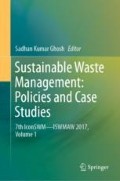Abstract
Solid waste management is one of the most important pillars in academic institutions where, as leaders of innovation in the society, they can easily adopt effective waste management programmes along with other environmentally conscious approaches to demonstrate sustainable principles which are socially and economically viable too. Such Green Campus Initiatives making the students appreciative and sensitive about this critical issue can provide a road map for others to follow. Accordingly, Guru Nanak Educational Campus located at North 24 Pargana, WB, tries to set example in the local community by implementing its green campus activities in phases. In the first phase, significant progress is already made under the following themes: the energy, biodiversity and waste management. The master plan for the entire campus implemented optimum land use through proper vertical and horizontal growth of the buildings, infrastructure developments with pitched roads, huge open playgrounds and picturesque lawns and optimum energy use in the campus as estimated following an energy audit. Installation of solar power plant and solar panels inside are two great steps taken in renewable energy use, meeting energy conservation partly. Proper transport management policy giving room for more walkability with less use of vehicles, management of generated wastes through outside agencies and maintenance of natural water body and habitat preservation are monitored regularly. But the measures for making green buildings, possible energy recovery from generated solid wastes and water recycling are the major issues still not addressed effectively. So in the second phase, another comprehensive plan is prepared including a detailed survey of the campus waste generation, its composition and possibility of energy output, identification of water use limit through water audit and its recycling processes. Their immediate incorporation can be of great help as these pollution free energy-efficient measures not only alleviates greatly the city’s negative impact on campus residents and its flora and fauna, but can give a strong message to the local people to change their mindset towards environmental issues.
Access this chapter
Tax calculation will be finalised at checkout
Purchases are for personal use only
References
Amrita website https://www.amrita.edu/center/green-energy.
Bhattacharyya, S. (2016). Solid waste management (SWM): Case studies at an educational campus and in the neighbourhood of Panihati, North 24 Pargana, West Bengal, India. In ICON SWM 2016 (to be published by Springer (India) Private Limited in a book on “Waste Management and Resource Circulation”).
Campus Green Builder. (2009). Campus projects: green building case studies Richland College.
Dahle, M., & Neumayer, E. (2001). Overcoming barriers to campus greening: A survey. International Journal of Sustainability in Higher Education, 2, 139–160.
Ibrahim, M. (2016). Sustainable waste management for campus construction projects—Case of UMass, Amherst, USA. In ICSCPM 16 Egypt
IIT Kanpur website www.iitk.ac.in.
Kennedy, C., et al. (2016). Getting to carbon neutral: Best practices in infrastructure strategy. A review of best practices in infrastructure strategy, Fifth Urban Research Symposium.
Panihati Municipality web site https://panihatimunicipality.in
Rwelamila, P. M. D., & Purushottam N. (2015). Green campus initiatives as projects: Can creating conducive internal university project environment a key to success? In Proceedings 31st Annual ARCOM Conference, 7–9 September 2015 (pp. 367–376). Lincoln: UK.
Source: Govt. of India, Ministry of Water Resources 2009.
Acknowledgements
The author would like to thank Mr. Debashis Chakrabarty, the Sanitation Inspector, Panihati Municipality, Mr. S. Saha, the GN Campus Electrician and Mr. Debasish Bhattacharyya, Campus supervisor for providing the data used to undertake the research, after studying and correlating those with the present investigation.
Author information
Authors and Affiliations
Corresponding author
Editor information
Editors and Affiliations
Rights and permissions
Copyright information
© 2020 Springer Nature Singapore Pte Ltd.
About this paper
Cite this paper
Bhattacharyya, S. (2020). Green Campus Initiative: Response from a Self-financed Educational Campus—A Case Study. In: Ghosh, S. (eds) Sustainable Waste Management: Policies and Case Studies. Springer, Singapore. https://doi.org/10.1007/978-981-13-7071-7_29
Download citation
DOI: https://doi.org/10.1007/978-981-13-7071-7_29
Published:
Publisher Name: Springer, Singapore
Print ISBN: 978-981-13-7070-0
Online ISBN: 978-981-13-7071-7
eBook Packages: Earth and Environmental ScienceEarth and Environmental Science (R0)

